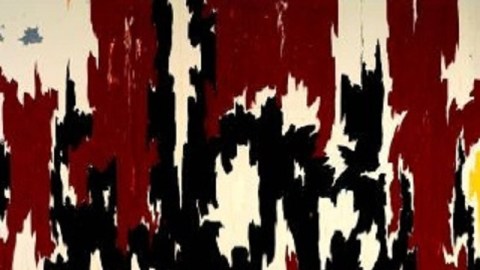Is Vandalism the New Art Criticism?

By pulling her pants down and defacing Clyfford Still’s painting 1957-J No. 2 (PH-401) (shown above, from 1957) last week at The Clyfford Still Museum, Carmen Lucette Tisch stumbled drunkenly into the annals of art vandals and, however misguidedly, art critics. Experts estimate that Tisch’s tush rub against (along with some angry punches at) the abstract painting worth between $30 and $40 million caused $10,000 worth of damage. An officer quoted in The Denver Post stated that he could see scratches and other damage to the surface of Still’s painting. Tisch also apparently attempted to urinate on the painting but, fortunately, had poor aim. What Tisch’s aims in attacking the painting, however, seem clear by her methods—to piss on the past and moon masterpieces eclipsing the art of the present. This may be only an isolated case, but could it be a sign of a new trend? Is vandalism the new art criticsm?
On December 29, 2011, Ms. Tisch entered the recently opened Clyfford Still Museum. Around 3:30 pm, in an apparent state of intoxication, Tisch leaned against the painting, one of the stars of the collection, and then physically assaulted it before guards could stop her. The authorities were summoned and Ms. Tisch was taken into custody and charged with criminal mischief. In her mugshot, Tisch looks directly into the camera with a defiant smirk. Her visible ink on her neck and chest cries out “I’m a bohemian.” A quick glance at her Facebook page gives little information save that she resides in San Francisco (although The Denver Post describes her as a Denver resident) and was born in Kansas City, Missouri. Instead of a profile photo of herself, Tisch uses an abstract painting as her social media face. Whether the painting is by her or if she is an artist is unknown. What is known is that Tisch has a criminal past, including an armed robbery charge dropped just weeks before the attack and a DUI from 2008.
If Tisch is an artist (and I admit it’s pure speculation based on circumstantial evidence, but stay with me), there’s an extra dimension to this attack. Plenty of struggling artists probably have wished they could rub butt cheeks against a work they felt didn’t deserve the praise it was receiving. This attack doesn’t have the mad, i.e., insane, feel of Laszlo Toth taking a hammer to Michelangelo’s Pieta in 1972 while claiming that he was Christ Himself. It has the mad, i.e., furious, feel of the Taliban dynamiting the Bamiyan Buddhas in 2001. Tisch may have needed some liquid courage before committing her crime, but the booze didn’t put the idea in her head. It was there, however tiny and ill-formed, before she walked in those doors. Differences in philosophy, religion, taste, etc., are fine, until someone or something gets hurt.
Is the coarseness of American discourse impinging upon art criticism? Hockney’s recent hit on Damien Hirst seems tame by U.S. standards, because it is. Ruskin charged Whistler with metaphorically “flinging a pot of paint in the public’s face” with his abstract art in 1877. Today, you’d see actual paint (or worse) flying. Just last November, conservative painter Scott LoBaido attempted to protest the Hide/Seek exhibition at The Brooklyn Museum with a painting of his own in response and had to be forcibly removed from the premises. Granted, LoBaido didn’t damage any art and was making a political as much as an aesthetic statement, but his aggressiveness stands on the same level as that of vandalism.
Perhaps Tisch is looking for publicity, much as I believe LoBaido is (and has been for years). How long before Tisch finds a gallery for her work (if such work exists)? Would this be a reward for her actions? Would her “critique” be justified? Museums have enough things to worry about without seeing their walls become physical war zones. Here’s hoping that this isn’t a trend, and that the weapons remain words and new works rather than punches and worse. It’s a shame that a new museum such as The Clyfford Still Museum has to face this challenge in its infancy, but maybe this can be an opportunity for the current state of American discourse to look at itself and finally grow up.
[Image:Clyfford Still. 1957-J No. 2 (PH-401), 1957. Oil on canvas, 113 x 155 in. Clyfford Still Museum Collection. © Clyfford Still Estate. Photo: Peter Harholdt.]
[Many thanks to The Clyfford Still Museum for providing me with the image above.]





